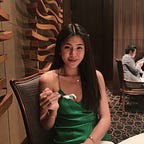Meditation on Fairies in a Bird’s Nest by John Anster Fitzgerald
The seasons run restlessly through it. All around seeds sprout and buds blossom, filling the air with sweet perfume. Rose bushes catch a rich color in the moonlight, basking their petals in the blossoming heat. The day is murmurous with the sounds of geckos and leaves. But the nymphs are the fairest of all, and the most graceful. Diaphanous peach robes skim their limbs as they lay in a bird’s nest, their delicate floral braids pooling around their waists in a teeming bed of life. Yet beyond the branched cocoon an eerie world awaits, where surreal creatures of the imagination disport themselves with wild abandon. They burst with a mysterious power beckoning from the past.
The painting hangs in the corner, enshrined in a large glass case and lit by warm ambient lights. As I approach Fairies, I am awed. It is like nature reflected in a pearl, exploding with greens, reds, oranges and pinks, shimmering by moonlight. Its jewel-like color against a shadowy background creates a tension between serenity and mystery. My eyes trace its glossy surface, moving from glazes thick and thin, opaque and transparent, harsh and soft. It is then I start to see the wind. Billowing from far beyond the sky, it rustles the dense foliage where the nest resides, then worms its way through the leaves, whistling and whittling as it stirs the air. Fitzgerald’s nuance is earthshaking.
It is only before Fairies I can appreciate Fitzgerald’s compulsive originality. Vignettes of the macabre temper his haven. His style is naïve and childlike, in a way suggesting the existence of an alternative world, one overlapping with our own, isolated only by a thin veil. We become his sleeping protagonists, wondrous dreams cavorting before us. Just like in real life, we have chanced upon this universe, one so similar yet dissimilar from our own. Perhaps seeing Fairies generates a link to the past. Not only does it transmit Fitzgerald’s genius as intended, but it also embodies the characters themselves. I am invited to an intimate communion with the floral and fauna, pixies and demons, enhanced by a twiglike golden frame extending messily into the distance.
This story is both loving and dark. Beyond their beauty, fairies were known for being terrifyingly amoral, even casting the birds eggs aside for horned goblins to feed on. They are at once enchanting and horrifying. Fitzgerald’s painting reminds me of supernatural depictions today. Every century comes with its own superstitions and anxieties. Our own cultural equivalents of superhuman life remain similarly rooted in our collective imagination. Maybe fairies embody the Victorian confrontations of new technologies and old religion, modernism and tradition. Fitzgerald’s work depicts a disenchanted world and his longing for a simpler time, much like how Renaissance artists yearned for ancient classical lore and how our contemporaries seek respite from technology in the most primal of locations — forests and seas.
Appreciating his art from a historical angle is reifying. Art history reminds me that superstition is more than a series of stifling tenets or rules. It is, for many, the atmosphere of life, a carefully cultivated way of seeing the world. Mystical art inspires awe because it instills sacramental meaning in things and opens a channel to the mysteries of life. Fitzgerald’s success thus hinges on his viewers’ willingness to accept his fantasies, hopping across the historical divide to embrace his narrative. Somehow, that leap is an easy one for me. As I look on, I begin mirroring the way Fitzgerald’s fairies held themselves — the soft angles of their bodies, the bend of their necks. I become a voyeur entering their atmosphere. Perhaps our worlds are not so far removed after all.
Fitzgerald reminds me of Hieronymus Bosch, both of whose works’ fantastical delicacy lends them a particular modernity. Disorienting scale and unnatural proportions makes Fitzgerald’s work even more alive. It explodes with the comprehension of the human bond with art, and how it touches our capacity to feel. Studying Fitzgerald’s work is important because the past hums with questions. In the Legion of Honor museum, where Fairies hangs, they resonate more than usual. Fairies is not just a painting; it is an instrument of an ancient narrative, a correspondence with another world. History is a story of paradigms borrowed, reworked, lived and put off. Fitzgerald’s painting is likewise rich with new and old myths guiding his imagination. Mystical art was his immortality. Let it be mine.
